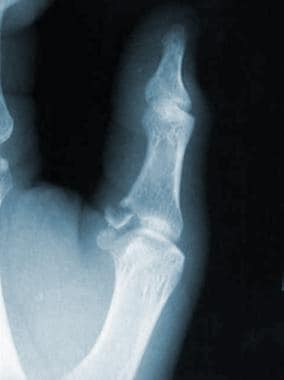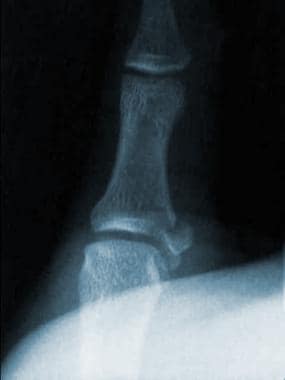Practice Essentials
Gamekeeper's thumb is an insufficiency of the ulnar collateral ligament (UCL) of the metacarpophalangeal (MCP) joint of the thumb. Campbell originally coined the term in 1955 because the condition was most commonly associated with Scottish gamekeepers (especially rabbit keepers) as a work-related injury. [1, 2] The injury occurred as the gamekeepers sacrificed game such as rabbits by breaking the animals' necks between the thumb and index finger of the gamekeeper and the ground. As a result, a valgus force was placed onto the abducted metacarpophalangeal (MCP) joint, leading to a ruptured ulnar collateral ligament (UCL) injury and chronic attritional injury that resulted in instability, which was accompanied by pain and weakness of the pinch grasp.
In the present day, this type of injury is typically more acute. The most common cause is a skier's hand landing on a ski pole, causing a valgus force on the thumb. [3, 4] The term "skier's thumb" represents the more acute nature of the injury. Because stability of the thumb is important for prehension, treatment is directed toward optimizing ligament healing to restore full function. [5]
Epidemiology
United States statistics
Gamekeeper's thumb is a fairly common injury, with an increased incidence in skiers that does not depend on the type of ski pole used. No known sex predilection is associated with this condition.
International statistics
No apparent difference exists in the international population with regard to the frequency or incidence of gamekeeper's thumb.
Functional Anatomy
The MCP joint is a diarthrodial joint that is primarily involved in flexion and extension. The static restraints and some dynamic stabilizers provide joint stability. The static restraints include the proper collateral ligament (mostly in flexion), the accessory collateral ligament (mostly in extension), the palmar plate (mostly in extension), and the dorsal capsule (limited, in flexion). The dynamic stabilizers include the thumb intrinsic and extrinsic muscles. The adductor mechanism is particularly important here, because it inserts onto the extensor expansion through its aponeurosis, which lies superficial to the UCL.
The UCL is a 4- to 8-mm X 12- to 14-mm band that originates from the metacarpal head and inserts into the medial aspect and base of the proximal phalanx of the thumb. Occasionally, when the UCL is strained, it avulses the bone at its insertion and leads to a gamekeeper's fracture, as shown in the 2 images below.
A Stener lesion occurs when the adductor aponeurosis becomes interposed between the ruptured UCL and its site of insertion at the base of the proximal phalanx. Thus, the distal portion of the ligament retracts and points superficially and proximally. A rupture of the proper and accessory collateral ligaments must occur for this injury to happen. The UCL no longer contacts its area of insertion and cannot heal. This lesion can also be associated with a gamekeeper's fracture, [6] which can be subtle or obvious (see the images above). However, a lump or mass over the ulnar aspect of the MCP joint of the thumb does not necessarily imply a fracture; it may be the result of the Stener lesion.
Sport-Specific Biomechanics
Considerable variation may be observed in the range of flexion and extension of the thumb MCP joint. The variation of normal joints can include ranges of motion (ROMs) from 5-115° of flexion and extension. In full extension, valgus laxity averages 6° and increases to an average of 12° in 15° of flexion.
Prognosis
Early diagnosis of gamekeeper's thumb injuries is one of the most important factors that determines functional outcome. In thumbs with partial ligament injuries, nonoperative treatment by immobilization will yield a stable, painless thumb with nearly normal motion in most cases. In thumbs with a complete rupture that are treated operatively within 3 weeks of injury, a good to excellent result can be expected in >90% of cases.
Pain and stiffness in the affected thumb can be expected to be mild or absent, and pinch and grip strength should be nearly normal. The rate of return to former activities, including recreational sports, has been reported as high as 96%.
Complications
Chronic instability of the MCP joint can occur despite a good surgical repair, especially if motion and return to play are resumed prematurely. This instability is difficult to treat and can lead to arthritic changes in the MCP joint, as well as weak pinch grasp in the long term.
-
Lateral radiograph displaying a gamekeeper's fracture.
-
Anteroposterior radiograph displaying a gamekeeper's fracture.
-
Radiographic stress test view of the thumb, showing an ulnar collateral ligament tear.
-
Ulnar collateral ligament stress test in full extension.
-
Ulnar collateral ligament stress test in a flexed position to isolate the proper portion of the ligament.
-
Anterior view of a hand placed in a thumb spica splint.
-
Lateral view of a hand placed in a thumb spica splint.









